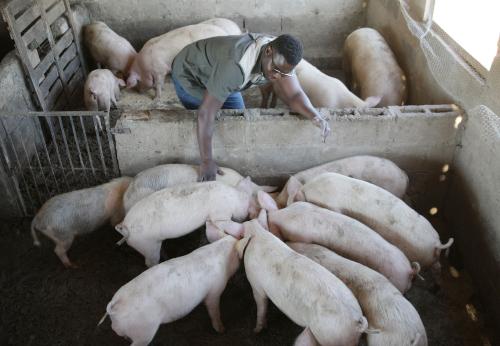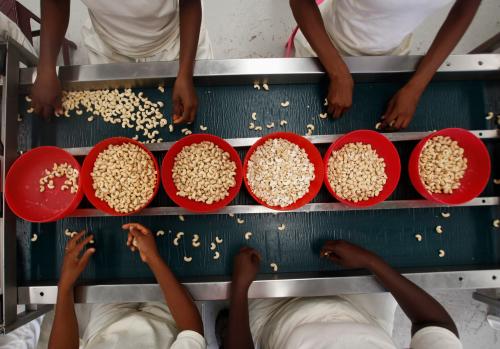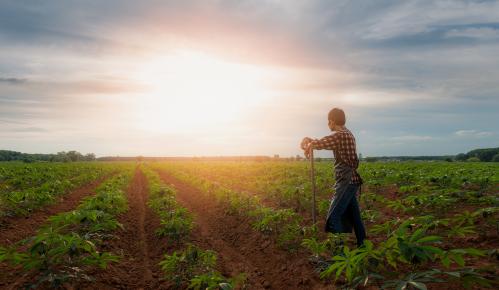Up to 80 percent of the labor force in low-income countries works in agri-food, mostly on the farm. In high-income countries, the proportion is still about 10 percent, more than half of them off the farm, in the related food industry and services, and many, migrant workers. Unsurprisingly, much hope is pinned on the agri-food system to tackle the global challenges of good-job creation and poverty reduction.
Meanwhile, agricultural automation is advancing rapidly, especially in developed countries; localization of food production is reducing access to external markets for developing countries; and anti-migrant sentiments are flying high. COVID-19 reinforces these trends of digitization and deglobalization. Furthermore, employment in agri-food historically declines as countries develop. So, what will be the role of agri-food in the future of work?
Overall, the challenge is to transition to fewer and better paying agri-food jobs—on-farm and increasingly off-farm along the agri-food chains—without causing social havoc and making maximum use of the many employment opportunities agri-food will continue to offer, particularly for youth. This challenge is going to be especially salient in Africa.
More and more diverse food with fewer laborers
As countries develop, people spend a smaller share of their income on food and more of it on nutrient-rich, processed, and convenient foods. This transformation is possible as farmers become more productive. Employment in agriculture declines, while new jobs are created off the farm, in the food industry and services, to cater to the changing customer demands (Figure 1). The expansion of off-farm, agri-food jobs partly compensates for the loss of on-farm work. Generated in towns close to poor populations, these off-farm jobs have also been an important factor in reducing poverty.
Figure 1. As economies grow, agri-food job creation shifts beyond the farm, while on-farm jobs become fewer and better
Source: Thurlow, 2020, Measuring Agricultural Transformation, presentation at USAID, Washington D.C. 2020 (https://www.slideshare.net/ifpri/aggdp-agemp-measuring-agricultural-transformation)
This process takes time. As a result, the agri-food system will remain a major employer for many decades, especially for lower-skilled workers in low and low-middle income countries, even though the trend in agricultural employment is fundamentally downward. Agricultural productivity is a key driver of this structural change. In the developing world during 1960-2000, every half-ton increase in staple yields generated a 14 to 19 percent higher GDP per capita and a 4.6 to 5.6 percent lower labor share in agriculture five years later. Continued investment in public goods is required to make agriculture more productive and help sort its workers into on- and off-farm activities including those in agri-food chains.
Digitization and deglobalization
As the transformation unfolds, societies evolve from having a surplus of domestic farm labor to a shortage. With inelastic food demand, an increase in productivity (a shift in the supply curve) will lead to a significant decline in food prices. Land markets are usually inefficient and food value chain development sluggish. This slows farm consolidation and diversification to higher-value crops, which are necessary for farm incomes to keep up with more secure and faster-growing incomes off the farm. Farming becomes increasingly unattractive for many, and agricultural workers become harder to find.
In higher-income countries this emerging farm labor shortage is often filled by foreign agricultural wage workers, especially in difficult-to-automate tasks like harvesting fresh fruits and vegetables. Headlines this spring of a shortage of 1 million seasonal migrant farm workers in Europe following COVID-19 mobility restrictions vividly illustrate this reality. Rising anxiety about the availability of migrant labor coupled with growing anti-migrant sentiments increasingly call this migrant labor model into question. Rapid advances in agricultural robotization, data mining, and sensor technology offer a viable alternative. Robo-weeders, automated strawberry pickers and now also vertical farms are just a few more recent examples of technologies that reduce the demand for labor. They also enable reshoring of agricultural production.
Agricultural deglobalization and digitization thus combine to (prematurely) close a door for agricultural labor and poverty reduction in lower-income countries. But agricultural digitization also offers important opportunities to increase labor productivity and raise incomes among many in the developing world. Hello Tractor, an Uber-like platform for tractor services that started in Nigeria, and Twiga Foods, a platform linking smallholder producers with urban consumers in Kenya, are just two examples. The applications are many and increasingly widespread, in agricultural extension, in finance (agri-wallet), in supply chain management (quality control), and in information management. Together they will accelerate the transformation toward fewer and better jobs, on-farm and also off- farm, including in the broader agri-food system.
Inclusive value chains, skills, and social insurance
To maximally exploit the employment opportunities the food system offers while brokering this transition, three policy areas demand attention. First, to raise agricultural labor productivity, we need to tackle several constraints at once. Inclusive value chain development (iVCD), which contractually links smallholder producers with other value chain actors, is increasingly the organizational solution of choice to accomplish this. Buyers can then secure higher volumes of better quality. They need this to access the more remunerative markets or to operate their plants at scale. Producers receive access to credit, agronomic knowledge, and a reduction of production, price, and/or market risk. But many questions and challenges remain, including the role of producer organizations and how to increase the productivity of staple crops for which iVCD is less effective.
Second, proactive measures must be taken to maximally benefit from agricultural digitization and tackle deglobalization. Accelerated regional integration in developing countries (such as the Africa Continental Free Trade Area) can help tackle the premature closing of overseas markets (for agricultural workers as well as goods). For new technologies to play their role, massive investment in skill development (including digital skills) must be pursued, commensurate access to infrastructure assured, and the threat of rising market concentration watched.
Finally, the global transition to fewer and better paying jobs, on and off the farm, is wrought with inertia and deep societal tensions. Many current farmers and agricultural wage workers will find themselves ill-equipped or too old to move off the farm. This situation often leaves a bifurcated agricultural workforce and a growing rural-urban divide: A minority of better educated, more entrepreneurial, younger farmers does well, while the majority of mainly older farmers struggles to survive. Simultaneous expansion of social security systems to avoid reversion to ineffective protectionist agricultural policies is needed. Decoupling social insurance provision from employment holds promise, with the massive ramp-up of social assistance across the developing world in response to COVID-19 offering a powerful platform to build on. Rising inequality, accelerated deglobalization, and technological backlash risk being the alternative.












Commentary
What is the future of work in agri-food?
December 11, 2020